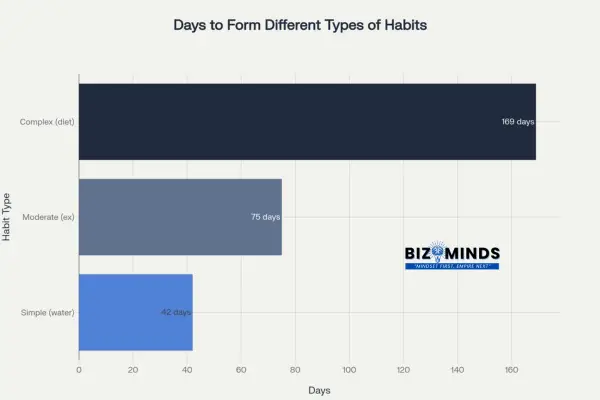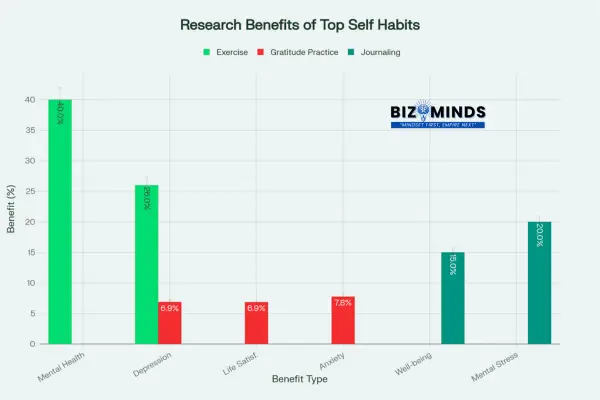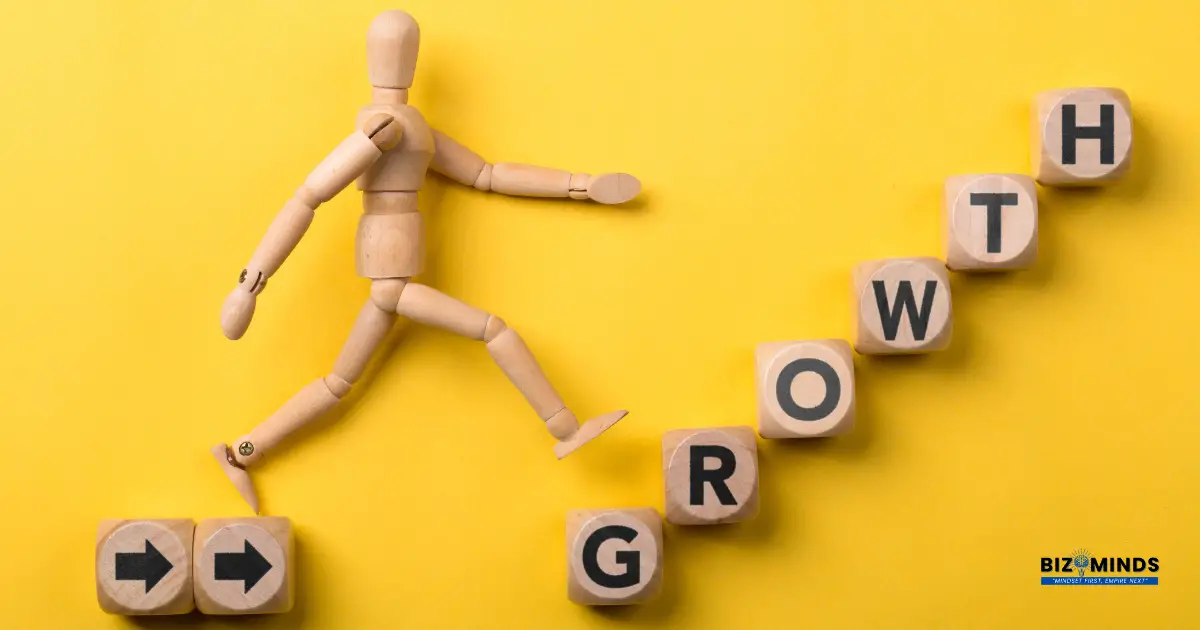

7 Essential Self Improvement Habits for Personal Growth
The pursuit of personal growth has never been more relevant than it is today. In America, where the personal development industry generates over $12.57 billion annually and continues growing at 3.7% each year, millions of people are actively seeking ways to transform their lives through meaningful self improvement habits. This massive investment reflects a fundamental truth: Americans understand that lasting change doesn’t happen overnight—it happens through the consistent practice of powerful, science-backed habits that compound over time.
New studies from University College London reveal that building genuine self‑improvement habits requires around 66 days on average, with certain habits taking up to 254 days—disproving the 21‑day habit myth. This finding transforms how we approach personal development, shifting focus from quick fixes to sustainable, long-term behavioral changes that create lasting transformation.

Research-based timeline showing how long different types of self improvement habits actually take to form, debunking the 21-day myth
The science behind building self‑improvement habits offers powerful, encouraging evidence that makes personal growth both engaging and achievable. Studies show that approximately 40% of our daily behaviors are automatic, meaning that by consciously cultivating positive habits, we can essentially program ourselves for success. Neuroscientists have discovered that habits create neural pathways in our brains, making positive behaviors easier to maintain over time while reducing the mental energy required for decision-making.
This comprehensive exploration of seven essential self-improvement habits draws from cutting-edge research, real-world case studies of successful Americans, and proven psychological principles to provide a roadmap for authentic personal growth. Each habit presented here has been validated by scientific studies and demonstrated to create measurable improvements in mental health, productivity, relationships, and overall life satisfaction.
The Science Behind Habit Formation and Personal Growth
Understanding the neuroscience of self improvement habits provides the foundation for creating lasting change. Charles Duhigg’s groundbreaking research in “The Power of Habit” reveals that all habits follow a predictable neurological pattern called the “habit loop,” consisting of three components: cue, routine, and reward. This loop becomes so ingrained in our neural pathways that habits eventually require minimal conscious effort to maintain.
James Clear’s “Atomic Habits” further expands this understanding by introducing the concept of “atomic habits”—small changes that compound over time to create remarkable results. Clear’s research demonstrates that getting just 1% better each day results in being 37 times better by year’s end, while getting 1% worse daily leads to near-zero progress. This mathematical reality demonstrates that building consistent self‑improvement habits is far more impactful than relying on sporadic motivation.
The Four Laws of Behavior Change, as outlined in Clear’s research, provide a practical framework for building self improvement habits:
- Make it obvious by designing clear environmental cues
- Make it attractive by pairing habits with immediate rewards
- Make it easy by reducing friction and starting small
- Make self‑improvement more rewarding through progress tracking and celebrating milestones
American meditation usage has tripled since 2012, with over 60 million adults (18.3% of the population) now practicing meditation regularly. This dramatic increase reflects growing awareness of how self improvement habits like mindfulness practice create measurable changes in brain structure and function, leading to improved emotional regulation, reduced stress, and enhanced cognitive performance.

Scientific evidence showing measurable percentage improvements from practicing key self improvement habits
Research from Harvard Medical School confirms that regular exercise produces antidepressant effects comparable to pharmaceutical interventions, but without side effects. A landmark study involving 1.2 million Americans found that those who exercised regularly experienced over 40% fewer days of poor mental health compared to sedentary individuals. These findings demonstrate the profound impact that physical self improvement habits can have on psychological well-being.
Habit 1: Morning Routine Optimization
For many Americans, the way the day starts—through habits and routines—directly influences productivity, focus, and overall success. Successful individuals from Tim Cook (Apple CEO) to Oprah Winfrey have attributed much of their success to carefully crafted morning routines that incorporate multiple self improvement habits into the first hours of each day.
Tim Cook famously wakes at 3:45 AM, using the quiet morning hours for email, gym workouts, and strategic thinking before most people begin their day. This early start provides uninterrupted time for personal development activities that might otherwise be crowded out by daily demands. Research supports this approach, showing that people who wake up early tend to be more proactive, better at anticipating problems, and more efficient in both professional and personal contexts.
The psychological benefits of morning routine optimization extend far beyond time management. A study published in the Journal of Health Psychology found that people with consistent morning routines experienced lower cortisol levels throughout the day, indicating reduced stress and better emotional regulation. The predictability of morning self improvement habits creates a sense of control and accomplishment that carries forward into other activities.
Key components of an effective morning routine include:
- Hydration: Drinking 16-20 ounces of water immediately upon waking helps kickstart metabolism and cognitive function
- Movement: Even five minutes of stretching or light exercise increases blood flow and energy levels
- Mindfulness: Brief meditation or breathing exercises help center thoughts and reduce anxiety
- Intention setting: Reviewing daily goals and priorities provides direction and focus
- Nutritious breakfast: Balanced protein and complex carbohydrates fuel both body and brain
Barack Obama maintained a structured morning workout routine even while serving as President, recognizing that physical self improvement habits were essential for managing the demands of leadership. His commitment to morning exercise demonstrates how prioritizing personal development, even during extremely busy periods, actually enhances rather than detracts from professional performance.
The neurochemical changes that occur during optimized morning routines create cascading benefits throughout the day. Morning sunlight exposure helps regulate circadian rhythms and boost vitamin D production, while early physical activity increases levels of brain-derived neurotrophic factor (BDNF), a protein that supports neural growth and cognitive function.
For Americans struggling with morning routine establishment, research suggests starting with just one self improvement habit and gradually building complexity over 2-3 weeks. The key is consistency rather than perfection—maintaining even a simplified routine provides more benefits than attempting an elaborate system that’s difficult to sustain.
Habit 2: Daily Physical Exercise
Physical exercise represents one of the most powerful self improvement habits available, with effects that extend far beyond physical fitness. The Harvard T.H. Chan School of Public Health conducted a comprehensive study revealing that running for just 15 minutes daily or walking for an hour reduces major depression risk by 26%. According to research, exercise can be just as effective as antidepressants for managing mild to moderate depression, offering benefits without medication risks.
The mental health benefits of regular exercise are particularly relevant for American professionals facing increasing workplace stress and anxiety. A 2023 meta-analysis of 97 research reviews involving over 128,000 participants found that all forms of physical activity—walking, resistance training, Pilates, and yoga—showed significant improvements in symptoms of mild to moderate depression. Resistance exercise appeared most effective for depression, while yoga and mind-body exercises provided the greatest anxiety relief.
American exercise trends reflect growing awareness of these self improvement habits. Home fitness equipment sales have surged, with the digital fitness market expected to reach $16.51 billion in 2024. Companies like Peloton and Mirror (now Lululemon Studio) have capitalized on preferences for convenient, home-based workouts that eliminate barriers to consistent exercise.
The neurobiological mechanisms underlying exercise’s mental health benefits are well-documented:
- Endorphin release: Physical activity triggers production of natural “feel-good” chemicals
- BDNF increase: Exercise boosts brain-derived neurotrophic factor, supporting neural growth
- Neurotransmitter regulation: Activity helps balance dopamine, serotonin, and norepinephrine levels
- Stress hormone reduction: Regular exercise decreases cortisol and other stress-related chemicals
- Inflammation reduction: Physical activity lowers inflammatory markers associated with depression
Research indicates that the optimal mental health benefits come from 3-5 exercise sessions per week, lasting 45 minutes each. However, even shorter durations provide significant benefits. A 2021 study found that just 10 minutes of daily physical activity could improve mood and energy levels.
American success stories demonstrate the transformative power of exercise as a foundational self improvement habit. Sara Blakely, founder of Spanx, credits her daily running routine with providing the mental clarity and stress relief necessary for building her billion-dollar company. Her experience illustrates how physical self improvement habits create the psychological resilience needed for professional achievement.
The compound effects of regular exercise extend into other areas of life. People who maintain consistent workout routines often report improved sleep quality, better dietary choices, increased productivity, and stronger social relationships. This demonstrates how one keystone habit can trigger positive changes across multiple life domains.
For Americans beginning an exercise routine, the key is starting small and focusing on consistency over intensity. Research shows that habit formation is more successful when new behaviors are easy to perform and immediately rewarding. Beginning with 10-15 minute walks and gradually increasing duration and intensity creates sustainable self improvement habits that last long-term.
Habit 3: Gratitude Practice and Positive Psychology
Gratitude practice has emerged as one of the most scientifically validated self improvement habits, with research demonstrating measurable benefits for mental health, relationships, and overall life satisfaction. Research from a comprehensive meta‑analysis shows gratitude interventions boost life satisfaction by 6.86%, enhance mental health by 5.8%, and lower anxiety (7.76%) and depression (6.89%) symptoms.
The growing popularity of gratitude practices among Americans reflects increasing awareness of positive psychology principles. Harvard Medical School research confirms that gratitude helps people feel more positive emotions, improve physical health, build stronger relationships, and better cope with adversity. These benefits explain why gratitude-focused self improvement habits have become central to many personal development programs.
Neuroscience research reveals the biological mechanisms through which gratitude creates these benefits. When people express gratitude, brain imaging shows increased activity in the hypothalamus (regulating stress) and ventral tegmental area (producing dopamine). This neurochemical response creates a positive feedback loop, making grateful thoughts and behaviors more likely to continue over time.
Effective gratitude practices encompass several evidence-based approaches:
- Gratitude journaling: Writing down three things you’re grateful for each day
- Gratitude letters: Composing thoughtful notes to people who have positively impacted your life
- Gratitude visits: Personally delivering gratitude letters and reading them aloud
- Gratitude meditation: Focusing mindfully on feelings of appreciation during quiet reflection
- Gratitude sharing: Regularly expressing appreciation to family members, friends, and colleagues
American celebrities and business leaders have publicly embraced gratitude as essential self improvement habits. Oprah Winfrey has maintained a gratitude journal for decades, crediting this practice with helping her maintain perspective during both challenging and successful periods. Her influence has inspired millions of Americans to adopt similar practices.
According to UC Davis researcher Dr. Robert Emmons, participants who wrote weekly gratitude journals reported improved health, consistent exercise, better life satisfaction, and stronger optimism compared to individuals who noted only hassles or neutral events. This demonstrates how gratitude practices create positive spillover effects across multiple life domains.
The timing and method of gratitude practice can influence its effectiveness. Studies suggest that gratitude journaling is most beneficial when done in the evening, allowing people to reflect on positive experiences from the day. Additionally, focusing on people rather than things, and being specific rather than general, amplifies the psychological benefits of gratitude self improvement habits.
For Americans struggling with stress and anxiety, gratitude practice offers a practical intervention that requires no special equipment or training. A 2018 study found that writing about gratitude for just 15 minutes three times per week over 12 weeks led to increased well-being and reduced depressive symptoms that persisted for months after the intervention ended.
The social benefits of gratitude practices are particularly important in American culture, where social connections have declined significantly over recent decades. Research shows that grateful people are more prosocial, less materialistic, and better able to maintain long-term relationships. These outcomes suggest that gratitude self improvement habits not only benefit individual well-being but also strengthen community bonds and social cohesion.
Habit 4: Reading and Continuous Learning
Reading represents one of the most accessible yet transformative self improvement habits, with American reading trends reflecting growing recognition of its personal development benefits. The personal development book segment is expected to grow at 6.1% annually, faster than any other category in the self-improvement market. This growth reflects increasing awareness that continuous learning through reading provides cognitive, emotional, and professional advantages.
Neuroscience research reveals that reading creates measurable changes in brain structure and function. A study using fMRI technology found that reading increases connectivity in the left temporal cortex (language processing) and central sulcus (sensory motor coordination), with these changes persisting for days after reading sessions. This neuroplasticity demonstrates how reading self improvement habits literally reshape the brain for enhanced cognitive performance.
Successful Americans across industries attribute much of their achievement to consistent reading habits. Warren Buffett, one of America’s wealthiest individuals, reportedly reads 500 pages daily and credits this habit with much of his investment success. Bill Gates reads approximately 50 books per year, focusing on topics ranging from global health to emerging technologies. These examples illustrate how reading self improvement habits provide the knowledge foundation for exceptional achievement.
The psychological benefits of regular reading extend beyond knowledge acquisition:
- Stress reduction: Reading can reduce stress levels by up to 68%, more effectively than music or tea
- Empathy development: Fiction reading increases emotional intelligence and social understanding
- Cognitive enhancement: Regular reading improves vocabulary, critical thinking, and analytical skills
- Memory improvement: Reading exercises working memory and supports long-term retention
- Focus strengthening: Sustained reading builds concentration and attention span
American reading preferences have evolved to accommodate busy lifestyles and technological advances. Audiobook consumption has grown by over 25% annually, allowing people to incorporate reading self improvement habits during commutes, exercise, and household activities. This flexibility removes traditional barriers to consistent reading practice.
Research indicates that reading just six minutes daily can reduce stress by 68%, making it more effective than other relaxation techniques. This finding is particularly relevant for American professionals managing high-stress careers and seeking accessible self improvement habits that provide immediate and long-term benefits.
The types of reading material significantly influence personal development outcomes. While fiction enhances empathy and emotional intelligence, non-fiction provides practical knowledge and skill development. Biographies offer insights into successful individuals’ thought processes and strategies, while self-help books provide structured approaches to specific challenges.
For maximum benefit, reading self improvement habits should include:
- Diverse genres: Mixing fiction, non-fiction, biographies, and technical materials
- Active engagement: Taking notes, highlighting key passages, and discussing concepts with others
- Regular schedule: Consistent daily reading times rather than sporadic long sessions
- Progressive challenge: Gradually increasing reading difficulty and complexity
- Application focus: Actively implementing insights from personal development readings
Digital reading platforms have revolutionized how Americans access and engage with books. Services like Kindle Unlimited, Scribd, and Audible provide unlimited access to extensive libraries, while apps like Goodreads help track reading progress and connect with other readers. These technological innovations support sustainable reading self improvement habits by reducing cost barriers and increasing convenience.
Research from the University of Rochester found that people who read regularly demonstrate better problem-solving skills, increased creativity, and enhanced analytical thinking. These cognitive benefits translate into improved performance across personal and professional domains, making reading one of the highest-return self improvement habits available.
Habit 5: Mindfulness and Meditation Practice
Once considered alternative, mindfulness and meditation are now core self‑improvement habits. In 2022, 18.3% of U.S. adults (60.5 million) practiced meditation, a sharp rise from 4% in 2012. This growth reflects mounting scientific evidence for meditation’s benefits and increasing acceptance in corporate and healthcare settings.
The American meditation market has exploded, with apps like Headspace, Calm, and Insight Timer achieving billion-dollar valuations. Calm was valued at $1 billion in early 2024, demonstrating significant investor confidence in meditation’s continued growth as essential self improvement habits. These platforms have made meditation accessible to Americans regardless of location, schedule, or prior experience.
Neuroscientific research provides compelling evidence for meditation’s brain-changing effects. fMRI studies show that regular meditation increases gray matter density in areas associated with learning, memory, and emotional regulation while decreasing activity in the amygdala (fear center). These structural changes occur after just eight weeks of consistent practice, demonstrating meditation’s power as transformative self improvement habits.
Key benefits of regular meditation practice include:
- Stress reduction: Meditation significantly lowers cortisol levels and activates the relaxation response
- Anxiety management: Mindfulness practice reduces anxiety symptoms and prevents panic attacks
- Attention improvement: Regular meditation increases sustained attention and reduces mind-wandering
- Emotional regulation: Practice enhances ability to observe emotions without reactive responses
- Meditation supports better sleep quality by improving sleep onset, extending sleep time, and increasing overall satisfaction with rest
American business leaders increasingly recognize meditation as essential self improvement habits for peak performance. Marc Benioff (Salesforce CEO) credits daily meditation with improving his decision-making and leadership effectiveness. Ray Dalio (Bridgewater Associates founder) has practiced meditation for over 45 years and considers it the most important factor in his success.
The accessibility of meditation makes it particularly valuable as foundational self improvement habits. Unlike exercise requiring specific equipment or environments, meditation can be practiced anywhere with minimal time investment. Research shows that even five minutes of daily practice provides measurable benefits, though 20-minute sessions produce optimal results.
Different meditation styles suit various preferences and goals:
- Mindfulness meditation: Focusing attention on present-moment awareness
- Loving-kindness meditation: Cultivating compassion toward self and others
- Body scan meditation: Systematically attending to physical sensations
- Breathing meditation: Concentrating on breath patterns and rhythms
- Guided meditation is a practice where users follow instructor‑led sessions delivered through mobile apps or recorded audio
Scientific studies demonstrate meditation’s effectiveness across diverse populations and conditions. A 2019 study involving over 1,000 participants found that meditation users showed significant improvements in psychological well-being, reduced symptoms of anxiety and depression, and better stress management compared to control groups. These benefits persisted for months after initial training periods.
The integration of meditation into American healthcare reflects growing recognition of its therapeutic value. Major medical centers including Mayo Clinic, Cleveland Clinic, and UCLA Health now offer meditation programs for patients dealing with chronic pain, anxiety, depression, and other conditions. This mainstream adoption validates meditation as evidence-based self improvement habits rather than merely spiritual practices.
Workplace meditation programs have shown remarkable results for American companies. Google’s “Search Inside Yourself” program reduced employee stress by 27% and increased emotional intelligence scores. Similar programs at Intel, General Mills, and Target have demonstrated improved employee satisfaction, reduced turnover, and enhanced productivity through meditation-based self improvement habits.
For Americans beginning meditation practice, starting small and maintaining consistency proves more effective than attempting lengthy sessions sporadically. Using guided meditation apps, joining local groups, or participating in workplace programs can provide structure and support for developing sustainable meditation self improvement habits.
Habit 6: Goal Setting and Personal Planning
Strategic goal setting and personal planning represent crucial self improvement habits that transform vague aspirations into achievable outcomes. Studies from the Dominican University of California show that people who document their goals are 42% more successful at achieving them than those who only visualize objectives. This finding underscores why successful Americans consistently prioritize systematic goal-setting as foundational self improvement habits.
The American personal development market’s emphasis on goal-setting reflects widespread recognition of its transformative power. With 35% of the global personal development market centered in North America, Americans invest billions annually in goal-setting programs, coaching services, and planning systems. This investment demonstrates understanding that structured planning creates accountability and direction essential for personal growth.
Neuroscience research reveals why goal-setting functions as such powerful self improvement habits. When people write down specific goals, brain imaging shows increased activity in the reticular activating system (RAS), which filters information and focuses attention on goal-relevant opportunities. This neurological change explains why people who set clear goals notice more resources and connections related to their objectives.
Effective goal-setting encompasses several evidence-based principles:
- SMART goals are defined as Specific, Measurable, Achievable, Relevant, and Time‑bound
- Written documentation: Physical or digital recording increases commitment and clarity
- Regular review: Weekly or monthly progress assessments maintain momentum
- Breakdown structure: Large goals divided into smaller, manageable action steps
- Accountability systems: Sharing goals with others or working with coaches increases follow-through
American business leaders exemplify the power of systematic goal-setting as essential self improvement habits. Ex‑American Express CEO Kenneth Chenault maintains productivity by ending his day with three written goals to achieve the following day. This practice ensures important priorities receive attention despite competing demands and interruptions.
Research from Harvard Business School found that MBA students who wrote specific goals earned ten times more than classmates who set no goals, twenty years after graduation. While this study has been questioned, subsequent research consistently shows strong correlations between goal-setting practices and achievement across personal and professional domains.
The psychological mechanisms underlying effective goal-setting include:
- Clarity enhancement: Written goals provide clear direction and eliminate ambiguity
- Motivation increase: Specific targets create urgency and focused energy
- Progress tracking: Measurable goals enable recognition of advancement and success
- Decision filtering: Clear objectives help evaluate opportunities and prioritize activities
- Confidence building: Achieving smaller goals creates momentum for larger challenges
Technology has revolutionized how Americans implement goal-setting self improvement habits. Apps like Todoist, Notion, and Evernote provide sophisticated systems for organizing objectives, tracking progress, and maintaining accountability. These digital tools make consistent goal-setting more convenient and effective than traditional paper-based methods.
The integration of goal-setting with other self improvement habits amplifies their collective impact. Research shows that people who combine written goals with regular review sessions, accountability partners, and consistent action plans achieve significantly higher success rates than those using any single approach.
American corporate culture increasingly recognizes goal-setting as essential self improvement habits for employee development and organizational success. Companies implementing systematic goal-setting programs report improved performance, higher engagement, and better retention rates. This workplace emphasis reinforces goal-setting skills that benefit personal as well as professional growth.
For Americans developing goal-setting self improvement habits, starting with quarterly or annual planning sessions provides structure without overwhelming complexity. Breaking large objectives into weekly and daily action items creates manageable steps while maintaining long-term vision and direction.
Habit 7: Journaling and Self-Reflection
Journaling represents one of the most versatile and accessible self improvement habits, with research demonstrating profound benefits for mental health, creativity, and personal development. Studies show that expressive writing can reduce anxiety, improve mood, boost immune function, and enhance overall well-being. These findings explain why journaling has become increasingly popular among Americans seeking effective, low-cost approaches to personal growth.
The therapeutic benefits of journaling are well-documented in psychological research. A landmark study published in the Journal of Experimental Psychology found that people who wrote about traumatic experiences for 15 minutes daily over four days showed improved immune function and required fewer medical visits in subsequent months. This demonstrates how journaling self improvement habits create both psychological and physical health benefits.
American leaders across industries have embraced journaling as essential self improvement habits. Benjamin Franklin maintained detailed journals throughout his adult life, using structured self-reflection to develop moral virtues and track personal growth. Modern leaders like Richard Branson and Bill Gates continue this tradition, using journaling to process experiences, generate ideas, and maintain perspective during challenging periods.
The neurological mechanisms underlying journaling’s benefits include:
- Emotional regulation: Writing about feelings activates the brain’s regulatory systems
- Cognitive processing improves with journaling, as it organizes ideas, clarifies thinking, and fosters new perspectives for personal growth
- Stress reduction: Expressive writing decreases cortisol levels and activates relaxation responses
- Memory consolidation: Recording experiences strengthens long-term retention and learning
- Creativity enhancement: Free-form writing stimulates divergent thinking and innovation
Research from Harvard Business School emphasizes journaling’s value for leadership development, noting that reflective writing enhances self-awareness, decision-making, and interpersonal skills. These findings suggest that journaling self improvement habits provide competitive advantages in professional contexts while supporting personal growth.
Different journaling approaches serve various purposes and preferences:
- Stream of consciousness: Unrestricted writing to explore thoughts and feelings
- Gratitude journaling: Daily recording of positive experiences and appreciation
- Goal-oriented journaling: Progress tracking and strategic planning documentation
- Problem-solving journaling: Working through challenges and generating solutions
- Creative journaling: Combining writing with drawing, poetry, or other artistic expressions
The accessibility of journaling makes it particularly valuable as foundational self improvement habits. Unlike practices requiring special equipment or environments, journaling needs only paper and pen or basic digital tools. This simplicity enables consistent practice regardless of location, schedule, or resources.
American mental health professionals increasingly prescribe journaling as therapeutic intervention. Research published in Advances in Psychiatric Treatment found that expressive writing reduces symptoms of depression, anxiety, and post-traumatic stress while improving overall psychological functioning. These clinical applications demonstrate journaling’s effectiveness as evidence-based self improvement habits.
Digital journaling platforms have expanded options for Americans seeking convenient, secure ways to maintain reflective practices. Apps like Day One, Journey, and Penzu provide encrypted storage, multimedia integration, and advanced search capabilities that enhance traditional journaling experiences.
A 2018 study involving medical patients with elevated anxiety found that online positive journaling for 15 minutes three times weekly over 12 weeks significantly improved well-being and reduced depressive symptoms. These benefits persisted for months after the intervention ended, demonstrating the lasting impact of consistent journaling self improvement habits.
For Americans beginning journaling practices, research suggests starting with brief, frequent sessions rather than lengthy, sporadic writing. Even two minutes of daily reflection can provide measurable benefits, with longer sessions offering additional advantages as the habit becomes established.
Creating Your Personalized Self Improvement Habits System
Successfully implementing multiple self improvement habits requires systematic approach rather than attempting wholesale lifestyle changes. Research on habit formation consistently shows that starting small and building gradually creates more sustainable results than dramatic initial efforts. This principle is particularly important for Americans managing demanding schedules and competing priorities.

Distribution of the $12.57 billion US personal development market across different delivery methods and formats
The habit stacking technique, popularized by James Clear, provides an effective method for integrating new self improvement habits into existing routines. Connecting new behaviors to existing habits allows people to use established neural pathways while creating new ones. For example, performing gratitude reflection immediately after morning coffee combines new practices with automatic behaviors.
Creating sustainable self improvement habits involves several key strategies:
- Start micro: Begin with extremely small versions of desired habits (2-minute journaling, 5-minute walks)
- Stack systematically: Link new habits to existing strong routines for automatic triggers
- Track progress: Use visual systems to monitor consistency and celebrate achievements
- Design environment: Modify surroundings to make good habits easier and bad habits harder
- Plan for obstacles: Anticipate challenges and develop specific strategies for overcoming setbacks
The compound effect of multiple self improvement habits creates synergistic benefits that exceed individual practices. Americans who combine exercise, meditation, and journaling often report enhanced mood, improved sleep, better relationships, and increased productivity compared to those practicing single habits. This multiplication effect explains why successful individuals typically maintain several complementary personal development practices.
Research from Stanford University’s Behavior Design Lab emphasizes the importance of celebrating small wins when building self improvement habits. Each time people acknowledge progress, the brain releases dopamine, reinforcing the neural pathways associated with the positive behavior. This celebration practice accelerates habit formation while maintaining motivation during challenging periods.
Environmental design plays a crucial role in sustaining self improvement habits. Americans can increase success rates by making positive behaviors more convenient and negative behaviors more difficult. This might involve placing workout clothes beside the bed, keeping journals in visible locations, or using phone apps to block distracting websites during focused work periods.
The integration of self improvement habits with existing social and professional commitments requires careful planning and realistic expectations. Rather than attempting to add hours of new activities, successful habit builders find ways to incorporate development practices into current routines and responsibilities.
Overcoming Common Obstacles to Self Improvement Habits
Despite good intentions, many Americans struggle to maintain self improvement habits due to predictable obstacles that can be anticipated and addressed proactively. Understanding these challenges and developing specific strategies for overcoming them significantly increases the likelihood of long-term success.
Time constraints represent the most frequently cited barrier to developing self improvement habits. However, research shows that this obstacle often reflects prioritization rather than actual time scarcity. Americans who successfully maintain development practices typically start with micro-habits requiring minimal time investment, then gradually expand as behaviors become automatic.
Perfectionism creates another common obstacle, with people abandoning self improvement habits after missing single sessions or failing to meet unrealistic standards. Research emphasizes that consistency matters more than perfection—missing one day doesn’t derail habit formation if people return to their routine quickly rather than giving up entirely.
Lack of immediate results can undermine motivation for self improvement habits, particularly in achievement-oriented American culture that values rapid outcomes. Understanding that genuine habit formation takes 2-8 months helps set realistic expectations and maintain persistence during periods when benefits aren’t yet apparent.
Effective strategies for overcoming common obstacles include:
- Implementation intentions involve creating specific if‑then strategies to manage challenges more effectively
- Identity-based approach: Focusing on becoming the type of person who maintains these habits
- Social accountability: Sharing goals with others or joining support groups
- Environmental optimization: Removing barriers and temptations while increasing helpful cues
- Progress tracking: Using visual systems to recognize advancement even during difficult periods
Social resistance can challenge Americans attempting to establish self improvement habits, particularly when friends or family members don’t share similar values or priorities. Research suggests that explaining the personal importance of these practices and inviting others to participate can reduce resistance while potentially inspiring positive changes in social networks.
Motivation fluctuation is natural and predictable during habit formation, with initial enthusiasm typically declining after several weeks. Understanding this pattern helps people prepare for motivational dips and develop systems that maintain consistency even when feelings change.
The role of identity in maintaining self improvement habits cannot be overstated. Research shows that people who view themselves as “the type of person who exercises” or “someone who prioritizes personal growth” are significantly more likely to maintain positive behaviors than those focused solely on outcomes.
Measuring Progress and Long-Term Success
Tracking progress in self improvement habits requires both quantitative metrics and qualitative assessments that capture the multifaceted nature of personal development. Research indicates that people who monitor their advancement are significantly more likely to maintain positive behaviors and achieve their goals.
Effective measurement systems for self improvement habits include:
- Frequency tracking: Recording how often habits are performed using apps, calendars, or journals
- Quality assessment: Evaluating the depth and satisfaction derived from each practice
- Outcome monitoring: Measuring specific benefits like mood, energy, productivity, or relationships
- Milestone celebration: Recognizing significant achievements and consistency streaks
- Regular review: Weekly or monthly evaluation sessions to assess progress and adjust strategies
Leading indicators provide more immediate feedback than lagging indicators, helping maintain motivation during the extended period required for habit formation. For example, tracking daily meditation minutes (leading) gives faster feedback than waiting to measure stress reduction (lagging).
The compound effect of self improvement habits becomes more apparent over time, with benefits often accelerating after initial establishment periods. Americans who maintain consistent practices typically report significant improvements in multiple life areas after 3-6 months of regular implementation.
Qualitative measures capture important aspects of progress that numerical tracking might miss. Regular self-reflection questions might include: How do these habits make me feel? What changes have others noticed? How have my relationships improved? What new opportunities have emerged?
Long-term success with self improvement habits requires periodic adjustment and evolution as circumstances change and goals develop. What works during initial habit formation may need modification as practices become automatic and life situations shift.
Conclusion
In summary, embracing these seven essential self improvement habits is a transformative journey that fosters genuine personal growth and lasting change. Harnessing the science of habit formation through manageable practices—morning routines, reading, journaling, mindfulness, gratitude, exercise, and goal setting—creates powerful pathways toward better mental, emotional, and physical health. These habits, validated by extensive research and exemplified by successful Americans, build resilience, confidence, and clarity essential for navigating life’s challenges.
Moreover, these habits work synergistically, creating a compounding effect that amplifies overall life satisfaction and productivity. By starting small, stacking new behaviors onto existing routines, and designing environments that support positive change, forming sustainable habits becomes an achievable, rewarding process. Overcoming common obstacles such as time constraints and motivation dips is possible with practical strategies, identity-based focus, and social accountability. This holistic approach transforms not just isolated behaviors but reshapes identities and life trajectories.
Ultimately, cultivating these self improvement habits goes beyond achieving goals—it cultivates a mindset of continuous learning, adaptability, and appreciation that enriches every aspect of daily living. The commitment to personal growth through these habits empowers individuals to live with purpose, intentionality, and fulfillment. By integrating these practices into daily life, people in the USA can build a foundation for profound success and well-being that endures a lifetime.
Frequently Asked Questions
1. How long does it really take to form self improvement habits?
Research from University College London shows that habit formation takes an average of 66 days, with simple habits forming in as little as 18 days and complex behaviors requiring up to 254 days. The popular 21-day myth has been thoroughly debunked by scientific studies. The actual timeline depends on the complexity of the habit, individual circumstances, and consistency of practice.
2. What are the most important self improvement habits to start with?
Based on scientific research, the most impactful self improvement habits are exercise (40% reduction in poor mental health days), gratitude practice (6.86% increase in life satisfaction), and morning routine optimization. These foundational habits create positive spillover effects that make other personal development practices easier to maintain.
3. How many self improvement habits should I try to build at once?
Habit formation research strongly recommends focusing on one habit at a time, or at most 2-3 related habits that can be “stacked” together. Attempting too many changes simultaneously typically leads to abandoning all practices rather than successfully establishing any. The key is building solid foundations before adding complexity.
4. Why do I keep failing to maintain self improvement habits?
Common reasons include starting too big, lacking environmental support, having unrealistic expectations, and focusing on outcomes rather than identity. Research shows that people who start with micro-habits (2-minute versions) and focus on consistency over perfection have much higher success rates than those attempting dramatic lifestyle changes.
5. What role does motivation play in building self improvement habits?
While motivation helps initiate self improvement habits, research demonstrates that relying on motivation alone leads to failure when feelings inevitably fluctuate. Successful habit formation depends more on environmental design, identity-based thinking, and systematic approaches that work regardless of momentary motivation levels.
6. How can I track my progress with self improvement habits effectively?
The most effective tracking systems combine frequency measurement (how often you practice) with quality assessment (how beneficial each session feels). Simple apps, habit journals, or calendar marking work well. The key is choosing a method you’ll actually use consistently rather than elaborate systems that become burdensome.
7. What’s the difference between habits and routines in personal development?
Self improvement habits are individual behaviors that become automatic through repetition (like daily meditation), while routines are sequences of multiple actions performed in order (like a morning routine containing several habits). Both are valuable, but habits require less conscious effort once established and are more resistant to disruption.
8. How do I maintain self improvement habits during stressful periods?
Research suggests preparing “minimum viable” versions of self improvement habits for challenging times. For example, if you normally journal for 10 minutes, have a 2-minute version ready for busy days. The goal is maintaining consistency rather than optimal performance during stressful periods.
9. Can self improvement habits really change my personality?
Neuroscience research confirms that consistent self improvement habits create measurable changes in brain structure and function, which can influence personality traits over time. While core personality remains relatively stable, habits can enhance characteristics like discipline, optimism, and emotional regulation through neuroplasticity.
10. What’s the best time of day to practice self improvement habits?
Morning practice is optimal for most self improvement habits because willpower and decision-making energy are highest after rest. However, the best time is ultimately when you can be most consistent. Some people succeed better with evening routines, and habit stacking allows integration throughout the day.
11. How do I know if my self improvement habits are actually working?
Look for both immediate and long-term indicators. Immediate signs include feeling more energized, improved mood, and increased sense of control. Long-term benefits typically appear after 2-3 months and include better relationships, increased productivity, enhanced resilience, and greater life satisfaction. Regular self-reflection and journaling help track these changes.
12. What should I do if I miss several days of my self improvement habits?
Research emphasizes that missing days doesn’t ruin habit formation if you quickly return to your routine. The key is viewing lapses as temporary interruptions rather than failures. Get back to your self improvement habits as soon as possible without self-judgment or attempts to “make up” for missed sessions.








